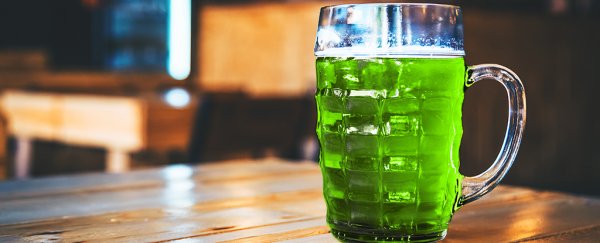Adding some blue to your food in the past has relied on synthetic dyes, which isn't to everybody's tastes and have been associated with allergies.
A natural alternative made from blue-green algae that was given the green light by the US Food and Drug Administration in 2013 can now be made in industrial quantities, thanks to new research which has found a way to boost its production.
Researchers at the Newcastle University in the UK working with Scottish Bioenergy have discovered a way to encourage the algae commonly known as spirulina to pump out more of a blue pigment called phycocyanin – by hitting it with a very precise frequency of light.
"Demand for phycocyanin has increased massively because people want natural not artificial food colourants, but at the moment it's still very expensive to produce," said researcher Chelsea Brain.
Blue is actually a rather rare colour in nature, with most examples being produced by light being scattered and not by a pigment.
For example, blue eyes are the result of blue wavelengths of light scattering more through the clear tissue of the cornea. In blue butterfly wings, the dusting of tiny scales will often refract light in ways that create an irridescent blue sheen.
Even the 'blue' in blueberries is caused by a purplish pigment called anthocyanin.
The bundle of proteins in plants called phycocyanin is one of the few examples of a chemical in nature which absorbs the longer orange and red wavelengths of light colours and spits out shorter, true blue wavelengths.
Phycocyanin is what's called an accessory pigment; a complex of proteins that work with chlorophyll to collect light and use it to lock up energy in the form of glucose molecules.
It is produced by a phylum of photosynthetic bacteria called blue-green algae, of which arthrospira – or more commonly, as a food source, spirulina – is a genus.
The pigment is both non-toxic to humans and water soluble, making it useful as a food dye.
There are currently just two other FDA approved blue food colourings – brilliant blue and indigotine, both of which are synthetic.
The fact that they are artificial has been enough for those who prefer 'natural' additives to seek an alternative, however studies that have hinted that these and other artificial colourings have contributed to children developing conditions such as attention deficit and hyperactivity disorder have further increased the demand.
So much so, that demand for phycocyanin now outstrips supply.
"Phycocyanin is already used as an anti-oxidant and anti-inflammatory, and the use of phycocyanin as a natural blue food colorant has experienced exponential growth in the past 5 years after being approved by the FDA as a food colorant in 2013," said DC Van Alstyne, CEO of Scottish Bioenergy.
To make arthrospira create more of this pigment, the researchers effectively put it on a 'diet' of red light within a very precise spectrum, forcing the algae to maximise production of the proteins in order to absorb as much light energy as possible.
"We found that we could produce over five-times the amount of 'blue' using long wavelength red light, reducing the cost of production and also improving efficiency," said Brain.
As anybody who has ever attended university can attest to, new discoveries are immediately followed by students asking how it can be combined with beer.
In this case, with Saint Patrick's Day approaching, the answer was clear.
By adding a touch of blue phycocyanin to the yellow of a pale ale, Newcastle University's student union created the traditional green of a celebratory Paddy's pint.
At last a discovery we can drink to.
